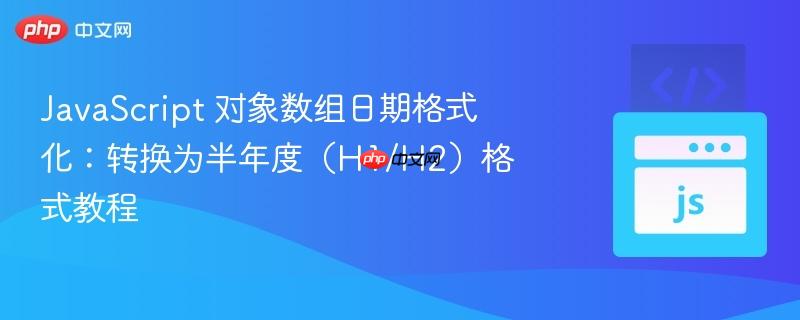
本教程详细介绍了如何在 JavaScript 中将对象数组中的日期字符串转换为半年度格式(如 'H1'2024' 或 'H2'2024')。文章将演示如何解析日期、判断所属的半年度,并提供两种实现方式:生成新的数组或原地修改现有数据,旨在帮助开发者高效地处理日期格式转换需求。
在现代Web开发中,处理和展示日期数据是常见的任务。有时,我们需要将标准的日期格式(如 'YYYY.MM.DD')转换为更具业务意义的表示形式,例如将一年划分为上半年(H1)和下半年(H2)。本教程将指导您如何在 JavaScript 中实现这一转换,特别是针对包含日期信息的对象数组。
我们的目标是将以下格式的日期字符串:
[
{'description': 'halfyear', date: '2024.01.01'},
{'description': 'halfyear', date: '2024.07.01'},
{'description': 'halfyear', date: '2016.01.01'},
{'description': 'halfyear', date: '2016.07.01'},
{'description': 'halfyear', date: '2020.06.15'} // 增加一个6月的示例
]转换为半年度表示,例如:
立即学习“Java免费学习笔记(深入)”;
[
{'description': 'halfyear', date: 'H1\'2024'},
{'description': 'halfyear', date: 'H2\'2024'},
{'description': 'halfyear', date: 'H1\'2016'},
{'description': 'halfyear', date: 'H2\'2016'},
{'description': 'halfyear', date: 'H1\'2020'}
]核心逻辑在于:
为了实现上述逻辑,我们可以按照以下步骤进行:
对于 'YYYY.MM.DD' 这种固定格式的日期字符串,最简单且高效的解析方法是使用 String.prototype.split('.') 方法。
const dateString = '2024.01.01';
const [year, monthStr, day] = dateString.split('.');
// year: '2024', monthStr: '01', day: '01'获取到月份字符串 monthStr 后,我们需要将其转换为数字进行比较。
const month = parseInt(monthStr, 10); // 将 '01' 转换为 1 const halfYear = month <= 6 ? 1 : 2; // 1-6月为H1,7-12月为H2
这里使用 parseInt(monthStr, 10) 确保将月份字符串正确解析为十进制整数,避免潜在的字符串比较问题。
使用 JavaScript 的模板字面量(Template Literals)可以简洁明了地构建新的字符串。
const newDateString = `H${halfYear}\'${year}`; // 例如 'H1\'2024'注意,在模板字面量中,如果需要输出单引号 ',可以直接写,或者在需要动态插入变量的地方使用 \ 进行转义,但在这里直接写是可行的,因为 \' 是在最终输出的字符串中作为字符。
根据是否需要保留原始数据,我们可以选择两种不同的数组处理方法:
当您希望保留原始数据结构,并在不修改原数组的情况下生成一个包含新格式日期的新数组时,可以使用 Array.prototype.map() 方法。
const originalData = [
{ 'description': 'halfyear', date: '2024.01.01' },
{ 'description': 'halfyear', date: '2024.07.01' },
{ 'description': 'halfyear', date: '2016.01.01' },
{ 'description': 'halfyear', date: '2016.07.01' },
{ 'description': 'halfyear', date: '2020.06.15' }
];
const transformedData = originalData.map(item => {
const [year, monthStr] = item.date.split('.');
const month = parseInt(monthStr, 10);
const halfYear = month <= 6 ? 1 : 2;
return {
...item, // 使用展开运算符保留对象中除date之外的其他属性
date: `H${halfYear}\'${year}`
};
});
console.log("--- 方式一:生成新数组 ---");
console.log("原始数据 (未改变):", JSON.stringify(originalData, null, 2));
console.log("转换后的新数组:", JSON.stringify(transformedData, null, 2));优势:
如果您希望直接修改原始数组中的日期,而不需要创建新的数组,可以使用 Array.prototype.forEach() 方法。这种方法会直接更新数组中的每个对象的 date 属性。
const dataToModify = [
{ 'description': 'halfyear', date: '2024.01.01' },
{ 'description': 'halfyear', date: '2024.07.01' },
{ 'description': 'halfyear', date: '2016.01.01' },
{ 'description': 'halfyear', date: '2016.07.01' },
{ 'description': 'halfyear', date: '2020.06.15' }
];
dataToModify.forEach(item => {
const [year, monthStr] = item.date.split('.');
const month = parseInt(monthStr, 10);
const halfYear = month <= 6 ? 1 : 2;
item.date = `H${halfYear}\'${year}`; // 直接修改对象的date属性
});
console.log("\n--- 方式二:原地修改原数组 ---");
console.log("修改后的原数组:", JSON.stringify(dataToModify, null, 2));优势:
日期解析的精确性:
操作符优先级与模板字面量:
选择合适的数组方法:
以上就是JavaScript 对象数组日期格式化:转换为半年度(H1/H2)格式教程的详细内容,更多请关注php中文网其它相关文章!

每个人都需要一台速度更快、更稳定的 PC。随着时间的推移,垃圾文件、旧注册表数据和不必要的后台进程会占用资源并降低性能。幸运的是,许多工具可以让 Windows 保持平稳运行。




Copyright 2014-2025 https://www.php.cn/ All Rights Reserved | php.cn | 湘ICP备2023035733号